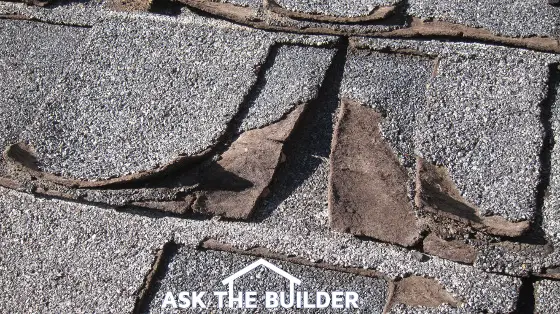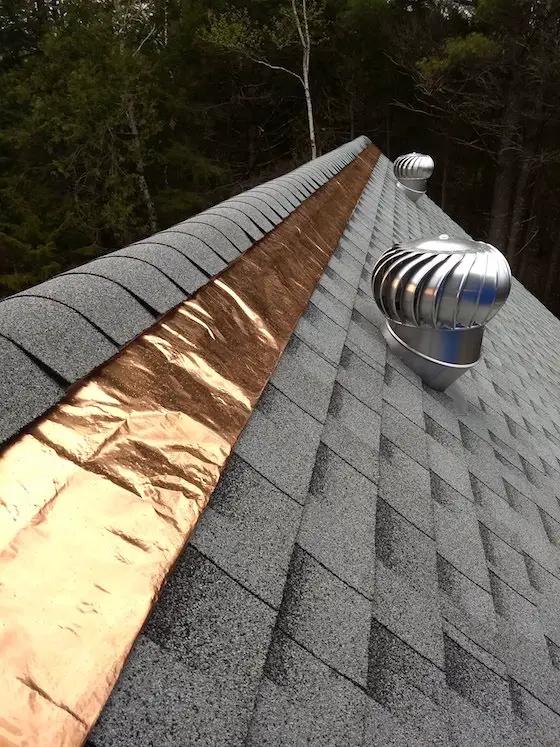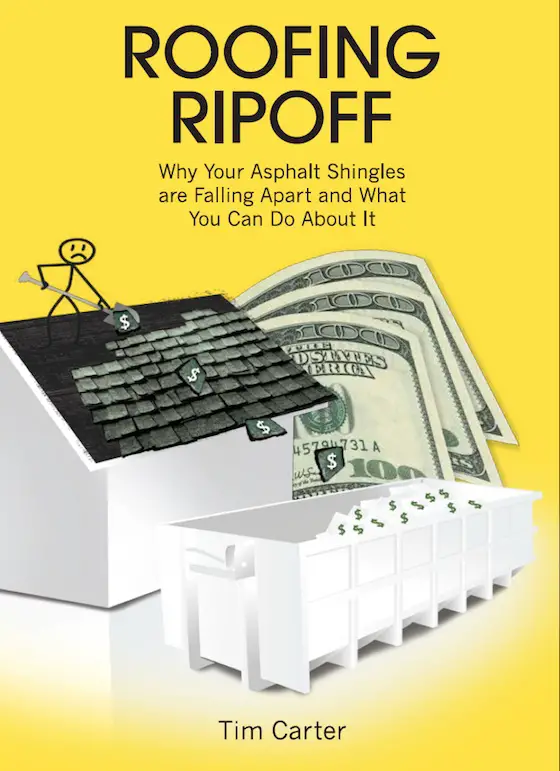Why Your Asphalt Shingles Are Falling Apart

These shingles were supposed to last 30 years. They started to fall apart in just nine years. (C) Copyright 2018 Tim Carter
Asphalt Shingle Failure
Question #1: Tim, I’m beside myself. My expensive asphalt shingles that have a 30-year warranty are less than ten years old and starting to curl. I see lots of roofs around me doing the same. I never recall observing this type of defect in all my past houses with asphalt shingles. Did I get a bad batch? What’s going on? Charlie, Raleigh, NC
Do your curled shingles look like the asphalt potato chips up on Charlie’s roof? Guess what, it happened to me. My own 30-year-warranty asphalt shingles started to fall apart in nine years and suffered a catastrophic failure just a few years later.
I was so angry I decided to reach out to the national association that represents most of the asphalt shingle manufacturers. They rebuffed me. I then tried to interview the top three USA shingle manufacturers. Two refused to answer my questions and the third company put so much spin on their answers I got dizzy reading them.
By this time, I was so infuriated I decided to see how widespread the defective shingle problem was. You may have participated in my national survey over two years ago. The results were so shocking I decided to write a short book about why your asphalt shingles are falling apart. The book is titled: Roofing Ripoff.
My research indicated the problem is happening all across the USA. In my opinion, it appears many of the shingle manufacturers are blowing too much air into the liquid asphalt at their factories. You need to blow some air into the asphalt, just enough so the black brew doesn’t drip from your roof on a hot summer day.
But blow too much air into the asphalt and you pre-age the shingles. Imagine opening a fresh pack of shingles only to discover they already have twenty, or more, years of wear built into them. It sounds like you got some of these poor-quality products.
I discovered something that can save you and millions of other homeowners billions of dollars. While doing research for my Roofing Ripoff book, I was the first person in the world to discover that copper ions react with asphalt molecules slowing down the aging process.
It’s been known for centuries that copper prevents algae and moss buildup on roofs and ship hulls, but I was the first to recognize copper can make asphalt shingles last 40, 50 or even more years! How cool is that?
For an existing roof, you just have to put a 12-inch-wide roll of very thin copper on top of the cap shingles that run across the ridge of your roof and any hips. The copper dulls down to an attractive medium nut brown in as little as four months so you don’t even see it.
Apply the copper strip just below the ridge shingles when you're installing a new roof. This allows you to blind nail the copper. Ideally, you want about 10 inches of copper exposed at the top of the roof on each side. Look at the following photo:

I was the first person in the world to identify that copper prevents the oxidation of asphalt molecules on asphalt shingles. See how easy it is to install this copper in a new-roof installation? CLICK the photo or TAP HERE to order the copper strips.
Each time it rains some of the tiny copper ions wash down onto the shingles. The copper bonds to the asphalt and prevents one asphalt molecule from connecting to an adjacent asphalt molecule. If too many asphalt molecules link together like a long freight train, the colored granules fall off and cause the shingles to curl up like a cat taking a nap. The copper ensures your roof will outlast your ownership of your home.
You must use solid copper nails to attach the discrete copper strip to your cap shingles. The copper is the same width as the cap shingles and will not interfere with any ridge ventilation products.
You can read the first three chapters of my Roofing Ripoff book for free. Go to: https://roofingripoff.com
Cleaning a Wood Deck with a Power Washer
Question #2: Tim, can you settle a disagreement between my husband and me? He wants to use a pressure washer to clean our gorgeous wood deck. I’m convinced that the concentrated pressure will harm the wood. He says it’s all about how far you hold the wand away from the wood and the degree of the tip of the tool wand. What say you? Terri, St. Paul, MN
Terri, you’re right. Pressure washers can wreak havoc with the soft fibers of wood, especially the light-colored bands of spring wood you see in all species of wood. Water that just flows over rock under no pressure other than its own weight scours solid granite. Just look at the Grand Canyon. Water spewing from a machine at 2,500 pounds per square inch is just too much.
Your husband does have a point with respect to the distance and tip size. Have him use a 40-degree tip and hold the wand at least 16 inches away. See what happens. Realize the closer the tip gets to the wood the more damage you’ll be doing.
Watch a short video showing the damage pressure washers do to treated lumber. Go to: How to Clean a Deck
Reference: April 25, 2016 AsktheBuilder Newsletter
Column 1248

2 Responses to Why Your Asphalt Shingles Are Falling Apart